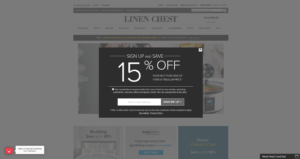E-commerce is rapidly growing, with double-digital growth expected to continue through 2020, and sales reaching an impressive $4 trillion. As this growth continues, so does an increased interest in purchasing home furnishings online, from throw pillows to blankets to a variety of larger furniture offerings.
In fact, by 2019, the global market for furniture and floor coverings is forecasted to reach $695 billion. As interest heats up, so does the competition as more retailers enter this online marketplace. Customers are harder to attract and retain with competitors always just one click away.
Savvy home furnishings companies are deploying a highly effective strategy — one that keeps competition at bay while building greater engagement and stronger relationships with each customer. But how? The answer is simple: greater website personalization.
Personalization significantly increases customer engagement with your brand on your e-commerce site – with forty percent of customers preferring to purchase from retailers that cater to their preferences. These statistics tell an interesting story, yet many home furnishings companies are still reluctant to adopt personalization, oftentimes because they aren’t sure where to start. Here are six tips to inspire greater personalization and higher revenue in the coming year.
Everything starts with a strong customer profile
When shopping for your birthday gift, a close friend has a profile of you in their mind — even if they don’t know it. They say: “Jane loves the color blue and she recently told me the pillows on the couch are wearing out. She needs new ones; in fact, I just saw her looking at some really great pillows at Crate & Barrel last week.” The friend remembers all these small pieces of data, and from this data, she comes up with the perfect birthday gift.
Creating a profile for each customer works in a similar fashion. The very first moment that you interact with the customer, you start collecting data points. But how do you capture this data? A great way is to provide a relevant offer during the first interaction.

For example, when a new person visits Crate & Barrel’s website, a pop-up offers a special coupon in exchange for an email address. The message says “Save 10% today when you sign up for up-to-the-minute offers, sales, and news.” Once you enter your email address, the retail company starts gathering various pieces of information about your search history, purchases and preferences. As a result, relevant offers can be sent via email, presented on the website and offered up with more precise timing.
However, even if your company doesn’t capture a visitor’s email address, you can still customize their experience. This is an important piece of information to consider since anonymous customers make up to 95 percent of website traffic. Personal data points, such as name, address and email address, aren’t collected, but what you can track is behavioral details, usually through cookies and other resources. As a result, customers can save items in their carts and you can customize recommendations during future visits.
Key takeaway: Track visitor data points from the very first visit, even if you don’t have personal identifying information yet. Doing this will help drive greater conversions through a personalized, more relevant online experience.
Understand customers in context
Building a customer profile for each visitor is a great start for creating more personalized experiences, but it’s also critical to put behavior in context.
For example, why is the customer interacting with your company at this exact moment? Factors constantly change based on a variety of contextual variables, such as seasonality. Home furnishings retailer Wayfair understands that as the holidays inch closer, customers expect a deal. For example, the week prior to Presidents’ Day, the company promoted a clearance sale, which featured discounts of up to 70 percent off retail prices.

While this offer is certainly appealing, it’s not personal. When clicking on the deal, you view icons, such as “Bedroom Furniture up to 65% OFF” and “Bedding up to 70% OFF.”

The offers are clearly a good value, but what if the customer isn’t in the market for new bedroom furniture — or any of the highlighted items? The potential sale is quickly lost. Instead of displaying the various icons above, this retailer could instead list deals specific to the exact customer based on recent search history.
For example, let’s say a visitor recently viewed a specific vase for their dining room table. They didn’t make the purchase, but during an upcoming sale that vase will be on sale. The retailer can then highlight items the customer recently viewed, such as the vase, that are now priced lower during the sale, as well as complementary items the customer may enjoy.
Key Takeaway: Personalization is about more than collecting pieces of information about each customer. It’s about understanding each customer in context. When you combine these two elements — personalization and relevant contextual information — you get much closer to unlocking a greater understanding of your customers and earning long-term loyalty.
Curate product picks
When visiting a mall, you may immediately walk up to the directory to locate retail stores that sell home furnishings. You then identify a few potential stores on the map, visit each store, find the appropriate department and sort through numerous products — until hopefully you find the desired item. Most shoppers know this process lacks efficiency and ultimately leads to shopping fatigue, especially if the customer is not successful in finding the desired product.
Online shopping is more streamlined than a traditional shopping experience; however, it still has inefficiencies. Curating product picks is an effective strategy that retailers can use to improve shopper satisfaction. Relevant items are displayed right off the bat — instead of forcing the customer to wade through numerous options until becoming fatigued and ultimately closing the browser.
Check out this example from Rug Studio. When displaying rugs, the home furnishings site provides additional customized recommendations based on viewing history. The “Coordinating Options” section ties in related products that complement the purchase. For example, you may see a complementary miniature rug that pairs nicely with your area rug.


Key takeaway: High-end stores have used the curated shopping experience for years. They get to know customers by name, learning their preferences and selecting items they’ll love. Curating online works in a similar way but allows retailers to personalize experiences at scale.
Personalize order shipping
Shipping can make or break the ability to convert a sale. This is why many online retailers offer free shipping. For example:
- Red Door found that adding a free shipping threshold increased orders by 90 percent.
- 2 Big Feet used a similar strategy and increased orders by 50 percent.
- ComScore found that having a free shipping day increased orders by 16 percent.
The powerful lure of free shipping is likely why programs such as Amazon Prime have become so popular. But surprisingly, the cost of shipping isn’t the only element that matters. Customers also want options for quicker delivery. These two items — free shipping and accurate and fast arrival options — are key elements to greater personalization. But why?
Shipping is an underused opportunity to personalize the buying experience. For example, your site might have a pop-up that says “Hey, Jane, it looks like you’re ordering holiday items. Do you want them to arrive faster?” At this moment, the customer feels a connection with a brand. The customer gets the sense that the retailer “gets” her pain point and has offered up a solution in the exact moment of relevance. What’s more, that faster shipping option may not be free, but that’s likely alright with Jane because she has a holiday party scheduled and getting items faster is more important than free.
This interaction can be further personalized by creating a customized “thank you” message that might read “Thanks for your order. We know you need these items fast, so rest assured they will arrive by December 15th, per your request.”
Key takeaway: Take advantage of this underutilized opportunity to personalize and forge greater loyalty with customers. As you deliver on your promises, customers will continually return to your brand to make purchases.
Create adaptive calls to action
Some home furnishings companies design one-size-fits all calls to action. For example, they may offer free shipping on orders of $50 or more. And while it often makes sense to provide free shipping, a call to action that is personalized generates greater long-term results.
For example, imagine that you’re a totally new customer of an online home furnishings store. You’re looking for decorative pillows for a new couch that you just purchased. When arriving to the online store, a “new customer” coupon appears. You think, “Wow, they understand I’m a new customer and this retailer is motivated to get my business — I’ll take a look at what they offer.” After viewing a few options, you make a selection and complete the purchase.
For example, Linen Chest offers a 15 percent off purchase coupon exclusively for new customers. After joining the email list and receiving the coupon, the offer no longer appears.

Let’s say you use the coupon, as highlighted in the example above, and a few weeks later you need to purchase an accent chair. Remembering the great deal you received prior, you visit the website again. But this time, the website offers another personalized coupon, saying “We’re thrilled that you’re back! Use this coupon as a token of our appreciation.”
Key takeaway: Personalized calls to action are an effective strategy for generating greater online conversions and moving customers through the sales cycle with less resistance. Test different offers and content to better understand what works best with your audience.
Personalize emails
How many emails do you receive each day? If you’re like most people, you receive dozens, if not hundreds, daily. This amount of email is simply impossible to open and read carefully, so a prioritization process begins, which involves skimming headlines and “bulk deleting” the majority of the emails.
Personalizing email campaigns increases open and click-thru rates significantly. In fact, according to Experian Marketing Services, personalization emails generate up to 6 times higher revenue per email than do non-personalized emails.
Marketers use personalized email for a variety of purchase situations, from enticing customers to return to abandoned carts to reminding them about items they previously viewed. For example, Amazon sends customers personalized emails that feature a recent product category in which the customer has searched. It might say something like “Customers who have shown an interest in ‘XYZ’ product might also like to know about these products” and highlight a few more options of interest.
Key takeaway: Don’t let personalization stop at the website. Integrate personalization strategies into email campaigns to ensure that customers feel known while maximizing your opportunity to cross-sell, upsell and close deals that would otherwise be lost.
Personalization: The key to greater results
Customers’ needs are changing. It’s true that people are buying more home furnishings online than ever before, but if you want to avoid becoming a commodity — easily interchangeable with your largest competitors — you need to adopt a new, more effective strategy.
Many website visitors shop several retailers at the same time, yet it’s still not only about price: Personalization is moving to center stage. Who understands the customer’s needs best? Who can offer the right product, at the right price — and at the precise moment of relevance? When your home furnishings company cracks this code, you gain an instant point of differentiation that can be leveraged against the competition.
What Is SLI?
At SLI, our machine-learning platform offers the most advanced technology available to accelerate your e-commerce and continuously delight customers at every click.
For more tips, check out our webinar: Predict More Sales with Personalization.








